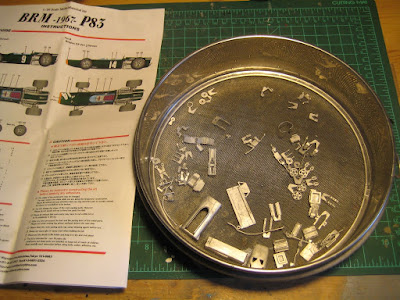The instruction sheet recommends assembling the two water radiators, complete with little phot-etched brackets and white metal hoses, then offering the completed assembly up to the front of the chassis just inside the nose cone. Looking at it all, I figured that the radiators needed to be supported during all this, and that taking advantage of the dowels and sockets associated with mating these to the chassis floor ahead of the front axle would be the best approach to ensuring these don't move around while said hoses and brackets are attached.

So the radiators went in OK, and only one of the four little photo-etched brackets got lost, pinging off into space. Maybe it will turn up, maybe not; I have been surprised in the past by what has turned up in the scarf and detritus when I clean up, sometimes days later. Hoses all line up fairly well. The critical part is the nose cone which is a tight fit over the radiators and the inboard springs and rocker arms. A lot of filing improved things but there is still a gap. Still you only really see it under the magnifying glass.

I have been careful to protect the body and other sub-assemblies from accidental damage by keeping them in little pieces of the bubble wrap that the kit came in. So far the paint on the body has stood up well to a fair bit of manipulation, but it is clear I will need to do some polishing before final assembly and decals.

There are people out there who market themselves as master model builders and offer to assemble things like this, at a price. Not having seen 'professional' work, I am not sure how good they really are; and I am not sure how they make a decent hourly rate unless they are really, really fast. And given the price of the unassembled kit, I assume you are looking at sums pushing $1000 to do this professionally, so it is really only for the very wealthy collector without the time or inclination to do it himself.
All in all this is a good build, so far (don't want to jinx it!). So stay tuned, rear suspension is next. This will require assembling little coil-overs with actual little steel springs that actually get compressed slightly, so the opportunities for stuff pinging off into the aether is exceptionally high.





















